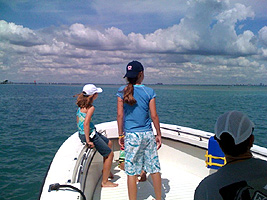1.11.6
About Key Biscayne
Key Biscayne has long been depicted as a tranquil sand and palm rimmed island lying in the lee of history. Its beauty is legendary, its tropical complexion described by travelers in the early 1880's. Yet recent discoveries and field work revealed that this low-lying subtropical island played a high profile role in the coastal and cultural development of Florida.
Key Biscayne property and resources have been sought and fought over by Indian chiefs and Presidents, heads of state, by generals, doctors, lawyers, coconut planters and developers.

President Richard Nixon arriving on his helipad located on the western side of Key Biscayne next to his 'Winter White House'.
The Tequestas were the first, arriving, in dugout canoes. They built a string of fishing and whaling villages raised above sea level on posts cut from local hardwood and palms. They banqueted on the island's succulent seafood from the shallows and offshore reefs. Sea turtles seasonally provided them with steak and eggs, sometimes shared with raccoons and small Florida black bears. Plants furnished tasty seeds, berries, and fruits such as sea grapes. Wildlife varied from the dunes to the hammocks to the wetlands. In the mangrove forests branches supported bird rookeries and interwined stilt roots served as water nurseries for marine life.

Sea Turtles next to the Cape Florida Lighthouse on Key Biscayne returning to sea after laying their eggs in the warm sand.
In 1513, Juan Ponce de Leon officially discovered the island, naming it Santa Marta, and claimed it for the Spanish King. He filled his ships' barrels with fresh water but did not remain long enough to realize that here was the Fountain of Youth.
Spanish plate ships took their northings from Cabo de Florida. Navigational error caught them on the treacherous coral reef, spilling silver and gold treasure still sought by salvors, divers and beachcombers.
When Florida was traded to England in the mid-1700's land was offered to encourage British Colonial plantations. Syndicates of investors were formed, and one was called the Cape Florida Society. But the era ended abruptly when Florida was traded back to Spain.
In 1790, petitions were entertained for Royal Spanish land grants. The first issued in South Florida was for Key Biscayne, predating Key West.

Key Biscayne and the Cape Florida Lighthouse on what is today the Cape Florida / Bill Baggs State Recreation area
Later a London-born American woman made history and a profit by selling a small fraction (3 acres) of her property to the U.S. government for the Cape Florida lighthouse, built in 1825. Using the lighthouse compound as a central plaza, she and her husband planned the first town of Key Biscayne in 1839, offering 264 lots at $500 each. A luxury resort and health spa were proposed but not built for more than 100 years.

Key Biscayne's first luxury resort hotel - The Key Biscayne Hotel and Villas, complete with oceanfront pitch and putt Golf course

President John F. Kennedy speaking at the Key Biscayne Hotel after narrowly defeating Richard Nixon in the 1962 elections.
Naturalists sang Key Biscayne's praises as butterflies and birds found it an inviting habitat. Plantation guests, arriving by yacht, described the private island as a romantic paradise out of the South Seas or West Indies. Key Biscayne became a favorite landing and gathering place of "the elite of the winter colony" as they opened the Miami Season.
Copyright 1995 by Joan Gill Blank, All rights reserved. Used with permission. "Key Biscayne - A History of Miami's Tropical Island and the Cape Florida Lighthouse"

Key Biscayne - still a romantic paradise, and a favorite landing and gathering place for the elite and for those elite in spirit.
Take a private boat tour with your friends or family.





